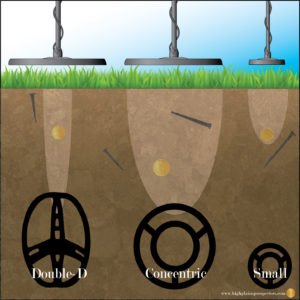
This is not my typical post. This is a compilation of tips and tricks I’ve learned about metal detecting… with a lot of help from my readers and my detecting family along the way. My goal in writing this post is to hep beginners and perhaps teach others a thing or two as well.
– The Right Machine –
The right machine is important. Whether you’re just starting out or looking to upgrade, you need a metal detector with the right features. I purchased my first (ACE 250)… and second (AT Pro) metal detector through Robert Wyatt at Quality Metal Detectors. Robert goes above and beyond. I encourage all my readers to call and speak with him whenever they express an interest in a new machine. His number is on the website.
I found Robert through Facebook. I had commented in one of the hundreds of groups and Robert sent me a PM. Even though I told him my budget was between $500-$700, he considered my needs and my experience level before recommending a machine. A good dealer will ask questions: Have you used a metal detector before? Where are you planning to detect? What is the terrain like? Will you be detecting in the water? What is your budget? What features are you looking for?
 In the end, Robert encouraged me to purchase the Garrett ACE 250. This is a great starter machine and far less than my expressed budget, but that’s the thing about Robert–he listens to what you need. I didn’t need some fancy detector with all the bells and whistles. At the time, I was just starting in the hobby. What if I didn’t like metal detecting? I would have been out $500-$700. The Garrett ACE 250 gave me the opportunity to immerse myself in the hobby without spending a bundle.
In the end, Robert encouraged me to purchase the Garrett ACE 250. This is a great starter machine and far less than my expressed budget, but that’s the thing about Robert–he listens to what you need. I didn’t need some fancy detector with all the bells and whistles. At the time, I was just starting in the hobby. What if I didn’t like metal detecting? I would have been out $500-$700. The Garrett ACE 250 gave me the opportunity to immerse myself in the hobby without spending a bundle.
A month ago, I upgraded from my ACE 250 to the AT Pro. There is a big difference between the ACE 250 and the AT Pro–and its more than the price. Right out of the gate, I was detecting with guys who’d invested hundreds into their machines. They had ALL the bells and whistles but one of the features I envied the most was the VDI.
In case you’re not familiar with the term, the VDI numbers identify the possible target. The numbers aren’t foolproof, but they help discriminate. With the ACE 250… I dug everything. I watched videos claiming that there was a low tone and a high tone, but I just couldn’t hear it. With the AT Pro, I had a little more information on the object I was targeting–both through the numbers and the tones. This was been huge but welcome change.
In the end, finding the right machine is about doing your research–whether you’re looking for a starter machine or looking to upgrade. A key part of that research involves speaking with someone with experience–whether that someone is a dealer or an experienced hobbyist. Make an informed decision, otherwise you may be setting yourself up for disappointment and no metal detecting experience should ever be disappointing.
– The Right Tools –
The Pinpointer – My most important tool is the Garrett ProPointer–and my recent upgrade to the Garrett AT ProPointer. A lot of the experienced metal detecting hobbyists will scoff at the ProPointer–but who could blame them? These guys and gals were metal detecting long before pinpointers. They’ve mastered pinpointing with their machine–something I’m still working on. I’m getting better at using the coil, but I would so much rather use the ProPointer when I’m rushing against the clock–which is most of the time.
 The Coil – I’m sure you’ve seen the diagrams on various forums and groups. The shape and size of the coil determines the depth and width of the signal. Whether you are relic hunting or coin-shooting, the size of your coil is important. In wide open spaces, the larger coil is thought to be best. In tight spaces, a smaller coil is more ideal. Even though a coil comes with every machine, sometimes it pays to exchange the generic coil for one better suited. My AT Pro came with the 8.5×11 DD coil, but I just purchased the 5×8 DD as a secondary for detecting creeks.
The Coil – I’m sure you’ve seen the diagrams on various forums and groups. The shape and size of the coil determines the depth and width of the signal. Whether you are relic hunting or coin-shooting, the size of your coil is important. In wide open spaces, the larger coil is thought to be best. In tight spaces, a smaller coil is more ideal. Even though a coil comes with every machine, sometimes it pays to exchange the generic coil for one better suited. My AT Pro came with the 8.5×11 DD coil, but I just purchased the 5×8 DD as a secondary for detecting creeks.
The Coil Cover – When I first opened my detector, I tossed the coil cover aside. I assumed the cover was to protect the coil when I was storing it… not when I was using it. Most of you probably already know, but the coil cover is to protect the coil while you’re using the machine. Keep in mind that the cover will not effect the depth or strength of the signal. In the end, the cover is a lot cheaper to replace than the coil. (Trust me, i just bought a secondary coil.)
The Digging Tools – I have the Garrett Digger which is useful for cutting plugs and hacking at the occasional root, but I eventually purchased a secondary spade from the local hardware store for $5. I loved this spade but whenever I used it during a hunt, the silly thing would break. Then–before the next hunt–I would purchase another. I dumped twenty-five bucks into the insanity before I was introduced to Predator Tools.
I’m brutal on my Raptor from Predator Tools–chopping at roots and prying at rocks–but it is insanely tough. Not only that, but it comes with a five year warranty. So, even if I do manage to break it–which is probably bound to happen–I get a new one.
The Towel – The towel is the unsung heroes of metal detecting. I use the towel when digging in a manicured lawn to put the property owner at ease. After cutting the plug, I scoop the dirt onto the towel and not onto the ground. Once I retrieve my object, I dump the dirt back into the hole and stomp the plug back in place. You’d never even know I was there.
 The Headphones – I hate wearing headphones, but headphones are the key to hearing weaker tones. When I’m in situations where I must headphones, I use the headphones that came with my machine–in both cases, I purchased a bundled deal that included headphones. However, you aren’t limited to the headphones that came with the machine. DetectorPro makes an awesome line of headphones–just make sure that when you are purchasing new headphones, you know which headphone jack your machine has.
The Headphones – I hate wearing headphones, but headphones are the key to hearing weaker tones. When I’m in situations where I must headphones, I use the headphones that came with my machine–in both cases, I purchased a bundled deal that included headphones. However, you aren’t limited to the headphones that came with the machine. DetectorPro makes an awesome line of headphones–just make sure that when you are purchasing new headphones, you know which headphone jack your machine has.
The Bug Spray – I’ve had Lymes Disease. Let me tell you, IT sucks. Bug spray is often overlooked, but I would very much recommend it–especially when your health is at risk. Lymes Disease is scary and includes a long list of health issues. I’ve been told that Sawyer Premium Insect Repellent is one of the best used by other hobbyists. I would encourage everyone to pick some up wherever you can find it and protect yourself from those pesky little ticks…. ’tis the season.
– The Right Location –
 Location is the key to great finds–I would expect almost everyone to agree. Given the choice between searching a home built in 2005 and a church built in 1740, I would choose the church. The odds of finding something spectacular at the newer home are slim, but the odds of finding something awesome at the church are substantial. This is why I stress, location is key.
Location is the key to great finds–I would expect almost everyone to agree. Given the choice between searching a home built in 2005 and a church built in 1740, I would choose the church. The odds of finding something spectacular at the newer home are slim, but the odds of finding something awesome at the church are substantial. This is why I stress, location is key.
I recognize that not everyone is comfortable with finding new locations and asking permissions, but don’t over-complicate it. Finding new locations is as simple as loading up the car and driving around haphazardly. Older homes are pretty easy to identify without much detective work. I encourage people to look under the skirt of potential permissions. By looking under the skirt, I mean checking out the foundation regardless of the siding. Even when someone has slapped new vinyl siding on a home, the foundation never lies.
Driving around is the easiest method for identifying locations, but a lot of experienced hobbyists take it a step farther than that. Sometimes, you just need devote yourself to the task of research. I pour through old maps. I google local histories. I spend time at the historical society. I talk to people at the post office, the park, the line at the grocery store–I am always initiating that conversation and planting that seed. It could be as simple as striking up a conversation about metal detecting during happy hour at the local pub.
These are methods for finding the prime location, the location that will produce the greatest relics.
– The Right Permissions –
Permissions are a tricky subject. Everyone has a different philosophy on permissions. My philosophy is to ALWAYS ask permission–whether the property is private, local, state, or federal. Some local municipalities have ordinances against metal detecting and the language is kind of cryptic with wording like “no one shall excavate or disturb vegetation.” Some state parks allow metal detecting, some require a permit, some don’t allow detecting at all. And my understanding of federal land is that metal detecting is never allowed, but I could be wrong.
Gaining permission to detect private property can be a little tricky. I’ve covered this subject in another post and will regurgitate the information here:
Once I’ve found my target, either through research or driving around aimlessly, I determine whether the home is occupied or vacant. If the home is occupied, I recommend personal interaction. I prefer catching people while they are working outdoors or getting the mail, but sometimes you have to knock on the door and hope that you’re not interrupting something important–otherwise you’re setting yourself up for rejection.
I usually start by introducing myself and explaining what I do–I pursue tangible history. This is harder for me than you might imagine, because I am not very debonair–I’m pretty awkward. Sometimes after my initial introduction, I catch myself spitting out as much information as possible before the homeowner has a chance to reject my proposal… then I remember to bite my tongue.
I’ve found that sometimes the most valuable talking points aren’t really talking points at all. Everybody loves show-and-tell. Sometimes bringing along something that I’ve found at a nearby permission helps grab the interest of the homeowners and saves me from having to talk too much. Also–and this is where that research comes in–knowing the area and being able to explain why you want to search the property is very important.
You need to realize that the property owner has no incentive to let you search their property. You really need to sell yourself and your calling.
Now, if the home is vacant, there are a couple options. 1) If there is a For Sale sign staked in the yard, call the realtor. They may be able to pass your information to the homeowner. 2) Scope out the neighboring properties and take a guess. If you guess wrong, the neighbor might be able to point you in the right direction. 3) Get the address and call the township or county. They can usually give you a name or address associated with the person who pays taxes on the property.
Remember that a epic permissions are the key to a epic finds. All the time you put into researching and networking and looking up skirts–the architectural variety–will pay off.
– Good Luck –
Think of this as my gift to beginners in metal detecting–a basic crash course if you would. This is a big chunk of the information I’ve absorbed over my short tenure in the hobby. A lot of it is common sense, but I’ve seen a lot beginners floundering in the online groups and seeking guidance. Not everyone asks questions and seeks advice like I have. I think my curiosity and my eagerness to learn has immersed me into the hobby and given me the tools to succeed. This is my attempt at passing that gift along.
I encourage everyone to reach out to more experienced hobbyists and learn from them–either on Faceboook or the forums. The detecting community is so vast and so eager to help. You are sure to get the answers you are looking for.
Good luck, everyone! Happy Hunting!